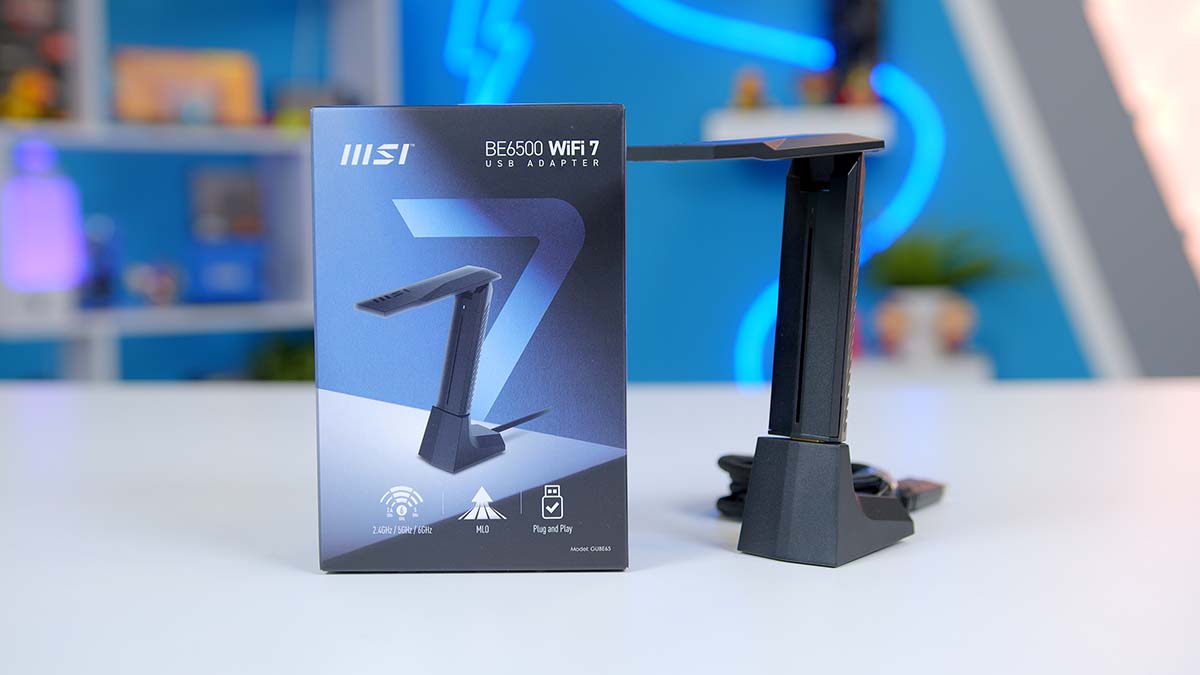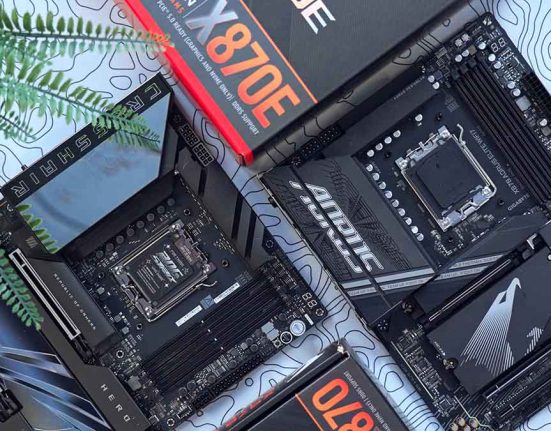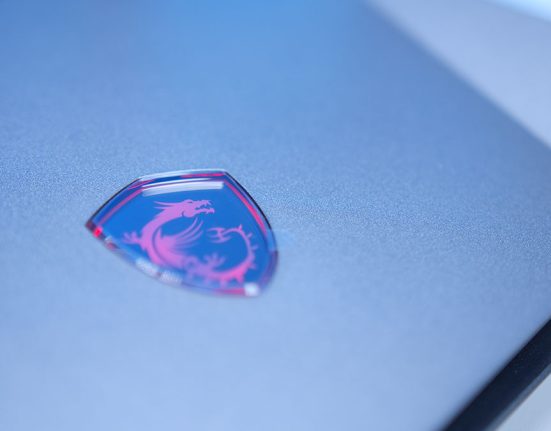The MSI BE6500 WiFi7 USB adapter provides a straightforward way to make your favourite devices WiFi7 capable without the hassle of needing to swap out critical hardware or make an expensive upgrade. This is an effortless plug-and-play device that enables your laptop, desktop, or portable machine to utilise the fastest wireless internet speeds that money can buy.
However, with so many modern machines utilising WiFi7 as default, the longevity of a device like the MSI BE6500 becomes questionable. WiFi7 has become the accepted standard across new motherboards and laptops, so those picking up new hardware can reap the benefits immediately. Additionally, with older hardware, if you don’t have a supporting WiFi7-capable router, something like the MSI BE6500 becomes redundant, as you’re not leveraging the throughput and bandwidth with the latest standard.
For now, though, we’ll leave this discussion until later in this review. In today’s article, we’ll examine the MSI BE6500 WiFi7 adapter in full detail, analysing the specs, design, and features and discussing the benefits/cons of WiFi7.
Buy the MSI BE6500 WiFi7 USB Adapter on:
Specification
Taking a look at the specs, on paper, the MSI BE650 is pretty well-equipped. This adapter uses WiFi7 by default but is backwards compatible, so if you don’t have a supporting router, WiF6E or WiFi6 will be perfectly adequate. You’ll max out your speeds and throughput on whatever band you’re using. If you upgrade your router later, you can still use this adapter with no issues.

Dimensions-wise, the BE6500 is pretty small, measuring 111mm long (fully extended), 33mm wide, and 20mm tall. We’ll touch on this in the design section, but when fully extended, it is a bit of an eyesore, which is where the stand comes into play. However, on its own the BE6500 is relatively compact which is great to see, I would’ve expected an adapter with this much power to be much chunkier, so it’s a welcome surprise to see something that can easily fit into your pocket.
Because this is WiFi7, you can access three WiFi bands: 2.4GHz, 5GHz, and 6GHz. Unfortunately, there’s no speed benefit from upgrading to WiFi7 from WiFi6E, as the 6GHz band arrived with 6E. However, thanks to the channel width used by WiFi7, there is much more available bandwidth. This effectively means you can host and provide incredible speeds across a larger number of devices if your router is WiFi7 capable.
| Specifications | MSI BE6500 WiFi7 USB Adapter |
|---|---|
| WiFi Standard | 7 |
| Dimensions (L x W x H) | 111mm x 33mm x 20mm |
| WiFi Speeds | 2.4GHz: Up to 688Mbps 5GHz: Up to 2800Mbps 6GHz: Up to 2880Mbps |
| Antenna | 2 x High Gain Tri-Band Antennas |
| WiFi Encryption | WPA-PSK WPA2-PSK WPA3-Personal WPA3-Enterprise |
| Interface | USB 3.2 Gen1 Type-A |
With regard to encryption, the BE6500 supports WPA3-Personal, which utilises heavy encryption, minimises password cracking like brute force dictionary attacks, and protects network devices by using newer protocols. WPA3 is the accepted standard for WiFi security, so it’s great to see it being used here.
Lastly, the MSI BE6500 adapter interfaces with your device through USB 3.2 Gen1 Type-A. These ports are rated at 5Gbps and are a requirement so that you can utilise WiFi7 to the fullest extent. Slower ports are likely to limit the speeds quite severely.
MSI BE6500 WiFi7 Design
Because this is a USB adapter, there’s not a huge amount to touch upon regarding the design. However, we’ll cover a couple of qualities worth noting here. As we’ve alluded to in the specs section, MSI has kept the device size fairly compact. This means it’s easy to carry around if you’re on the go and shouldn’t be much of an encumbrance on your desk. However, the caveat is that it has a fairly chunky width. The downside is that it may affect your ability to plug other devices into neighbouring ports.

This won’t be an issue for everyone, especially if you’re using a desktop machine, but those with a laptop may lose a port or two with the USB adapter plugged in. However, you can avoid plugging the adapter directly into your machine using the stand. The stand has a USB port in the top, which the adapter plugs into, and a cable going out, which will then go into a supporting device.

I don’t mind the stand, as it provides a different way to house the adapter. However, when the adapter is fully extended, it’s a bit of an eyesore and tends to stick out. If you’re using this on the go, having to carry a stand around with you would be somewhat inconvenient.
Aesthetically, the MSI BE6500 adapter will blend in with most dark setups. The entire chassis, along with the cable and the stand, is black. There is a small blue light on the back, but this indicates that the adapter is working and doesn’t take away from the overall design. To summarise, MSI has kept things simple. This WiFi7 adapter isn’t flashy and will work well in a professional setup, but its size may be an encumbrance depending on your use case.
What is WiFi7 – Upsides and Downsides
Before we look at this adapter’s features, it’s first worth discussing what WiFi7 is and what it can offer. One of the big misconceptions thrown around by manufacturers is that ‘WiFi7 massively increases speeds, and you should buy a router because of this’. However, this isn’t entirely true. While WiFi7 offers a speed increase, this is mostly theoretical. WiFi6E to WiFi7 sees speeds increase to 46Gbps, which is impressive but isn’t the most crucial quality of WiFi7 and also likely isn’t an achievable number for the vast majority of devices.
WiFi7’s most significant upside is how it handles network density. What I mean by this is handling a larger number of devices across a network. New WiFi standards are primarily focused on improving wireless internet connectivity as a whole, allowing you to enjoy your favourite videos without them buffering or scrolling through Instagram without an infinite load because someone is hogging all of the bandwidth.

WiFi7 allows users to enjoy better connectivity and greater speeds across numerous devices on a network, as the core of the network is built to withstand this. There are a couple of caveats however. The first is that you need a supporting router. WiFi7 devices can operate on a WiFi6E network because of backwards compatibility, but you can’t leverage the benefits and speeds without the infrastructure. Unfortunately, WiFi7 routers are pretty expensive at the time of writing, and we will likely not see any major price drops for a couple of years.
The other caveat is the use case. WiFi7 hasn’t quite become mainstream across all devices. Not every new phone and tablet supports it, and the same goes for laptops and desktop machines. If you don’t have that many WiFi7-compatible devices, spending $200+ for a WiFi standard that you won’t be using feels pointless.
Features We Like
Plug and Play
One of the main benefits of the MSI BE6500 is that it is plug-and-play. You simply plug it into a USB 3.2 Gen1 port, install drivers, and then connect to your network. This is an incredibly simple process to get it set up and working.

Ideal for Working on the Go
If you constantly travel with a laptop but your machine doesn’t support WiFi7 out of the box, then the MSI BE6500 is an ideal device for you. It offers the convenience of having a small footprint, so it’s easy to take on the go. Additionally, because it’s so simple to set up, if you need quick network speeds, you can quickly plug it in and use the blazing-fast 6GHz band.

Features We Don’t Like
May Block USB Ports
One of the significant caveats of this particular device is its width. Because of the size of the adapter, it may block off neighbouring USB ports, limiting your options if you want to plug in extra accessories.

Requires USB 3.2 Gen1
This USB standard has been around for quite some time, but not all machines will have spare USB 3.2 Gen1 ports, especially if you’re using a compact laptop. If you don’t have any ports to spare, the MSI BE6500 might not be for you.

Conclusion
MSI BE6500 WiFi7 Adapter

Product Name: BE6500 WiFi7 Adapter
Brand: MSI
-
Features
-
Design
-
Performance
-
Value For Money
Summary
The MSI BE6500 WiFi7 USB adapter is a solid accessory for your home or work setup. This fairly compact device offers prospective buyers a fully plug-and-play experience and the ability to leverage the benefits and speeds of WiFi7 wherever you go. This USB adapter has an extendable design providing greater range and signal but can also remain in its compact form to make it easier to travel with. Additionally, the BE6500 adapter is available for around $100 at the time of writing, which is a reasonably affordable price point considering the benefits on offer here.
However, there are a couple of caveats worth considering. The first is your use case. If you don’t have a supporting WiFi7 router, this may not be the accessory for you. Furthermore, because the MSI BE6500 requires a USB 3.2 Gen1 to work, you’ll need to make sure you’ve got ports to spare, or else you won’t be able to leverage the advantages of WiFi7.
Pros
✅ Affordable
✅ Great for travelling with
✅ Plug and play
Cons
❌ May block USB ports
❌ Requires USB 3.2 Gen1
❌ Somewhat niche use case








